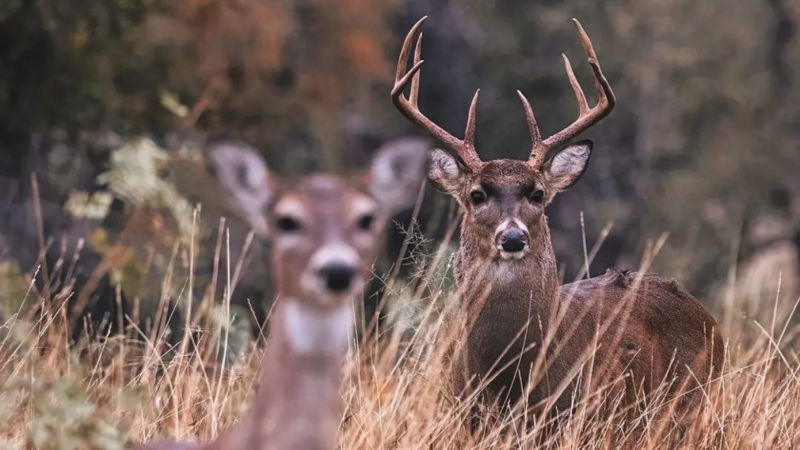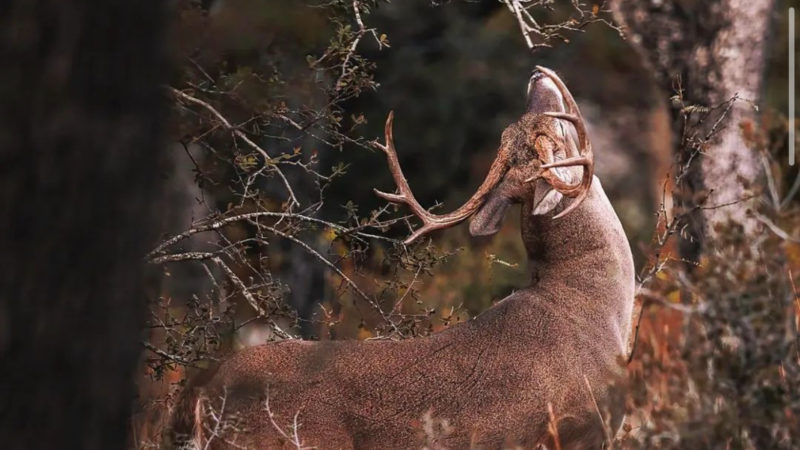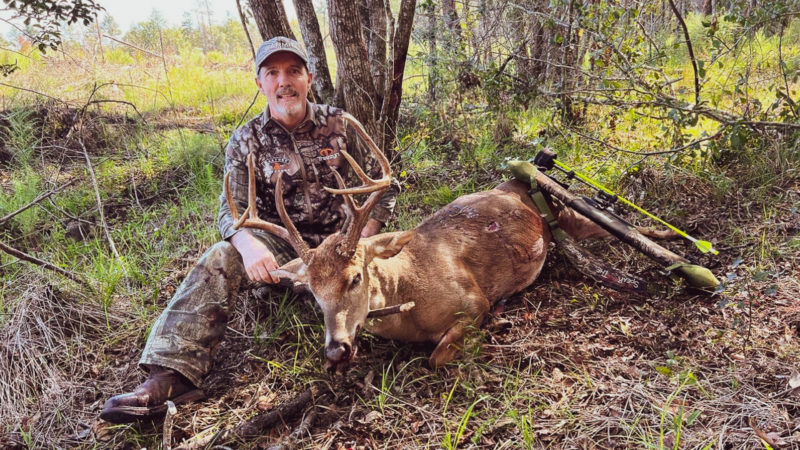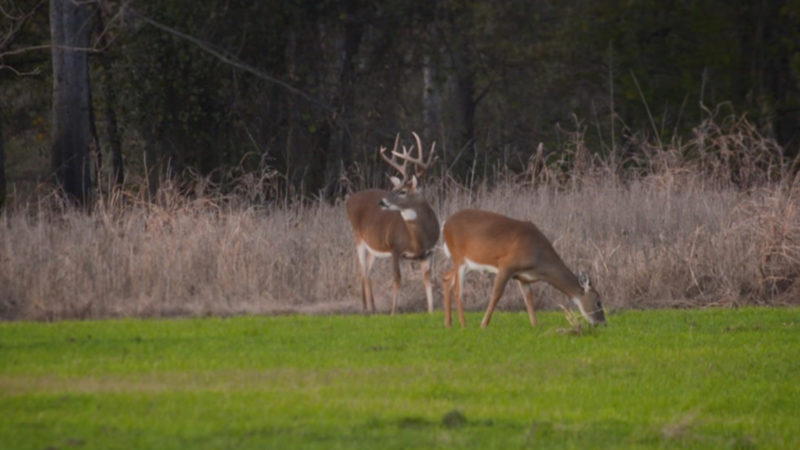For most deer hunters across the country, December means rutting activity has all but wrapped up, and late-season food sources become key to filling those remaining deer tags. But for some fortunate hunters in the Deep South, the rut is just now cranking up and the best hunting is yet to come.

Why the Odd Rut Timing?
Most whitetail breeding occurs over a fairly narrow window of time in the Midwest and Northeast. That’s out of necessity. Any breeding that occurs outside of that window will result in early or late-born fawns that are much less likely to survive the harsh winter conditions they may encounter. Researchers believe that estrus timing is encoded into a does genes, so any fawns born to does with early or late estrous cycles wouldn’t likely survive to pass those genes on. That’s why hunters in the Midwest and Northeast enjoy a short, but very intense rut.
In the South, rut timing isn’t near as critical. The weather is much milder, and abundant food is available for most of the year. That allows rutting activity in the South to be much more drawn out. But even a drawn-out rut doesn’t explain the seemingly random variation of southern states’ rut dates. For instance, where I live in west-central Georgia, we have a traditional early to mid-November rut. But with a short drive across the Alabama line, I can enjoy rutting activity in mid-January, after the Georgia deer season has wrapped up.
Many deer biologists believe this variation in rut timing is due to 20th-century restocking efforts. Some of the southern states brought deer in from different parts of the country, creating a hodgepodge of genetics, which has led to the broad spectrum of rutting activity.
So, the good news for southern hunters is they have the opportunity to hunt the rut over a period of a few months without having to leave their state in many cases. The bad news is, because the rut in these areas is more drawn out, you’re not as likely to witness the fast and furious rutting activity that you might encounter in the Midwest or Northeast. But it can still be a magical time if you time things just right.

States with a Late Rut
Hunters looking to take advantage of late rutting activity have a few options. Florida, Georgia, Alabama, Mississippi, and Louisiana all offer excellent late-season deer hunting opportunities. Here’s a look at each and where you can take advantage of late season rut activity.
Florida
Florida has the craziest rut timing of all the southern states, extending from July into February, nearly half the year! While Florida is not typically thought of as a deer-hunting destination, it’s certainly an option for those wanting to extend their hunting season at a reasonable price. The early breeding activity starts in the southern tip of the state, and the further north you go, the later the rut. For late-season rut activity, look to the panhandle for opportunities from December through February.
Nonresident hunters will need a Florida hunting license ($151.50) and deer permit ($5), along with the applicable archery, muzzleloader or firearm permit ($5 each).
Georgia
My home state of Georgia has excellent deer hunting with several post-November rut hunting opportunities. Rut timing is a little patchier than with some of the other southern states, so look to the North Georgia mountains for a late November/early December rut, and the southwest corner of the state for December and January opportunities.
While public land opportunities abound in North Georgia, be aware that deer densities there are low. It can be tough hunting, both physically and mentally. There are some good bucks to be found, though.
Nonresident Georgia deer hunters will need a hunting license ($100 annual or $20/one-day plus $6 each additional day), big game permit ($225 annual or $130/one-day plus $8 each additional day), and big game harvest record (free).

Alabama
With the exception of a handful of counties scattered around the state, Alabama hunters get to enjoy a rut that extends from early December clear into February. Like Georgia, the various rut timings are scattered in a somewhat irregular pattern. You really just need to look at a rut map to get a real feel for things. If you really want to get into the later dates of the rut, look to the southern half of the state, particularly the southwestern counties.
Nonresident Alabama hunters will need an all game Alabama hunting license ($350.15/annual; $216.20/10-day trip; or $152.55/3-day trip). Those hunting the state’s wildlife management areas will also need a Wildlife Management Area License ($20.05 annual)
Mississippi
If it’s late rutting activity you’re after, then anywhere in Mississippi will fit the bill. Starting in the northwest corner of the state, peak breeding dates are December 9-16, and they get progressively later as you move toward the southeast corner of the state, finishing up between January 24 to February 6.
Nonresident deer hunters will need a Mississippi All Game Hunting License ($300/annual; $150/7-day; or $150/3-day), an Archery/Primitive Weapon/Crossbow license (for annual and 7-day license, $75), and a Deer Permit ($50). If you’re hunting on state Wildlife Management Areas, you will also need a Wildlife Management Area User Permit ($30).

Louisiana
Louisiana offers lengthy rut hunting opportunities from October to January. The eastern half of the state provides the latest rutting dates, with a patchwork pattern of December and January breeding dates.
Nonresident Basic Hunting license ($200/annual; $65/5-day) and a Deer permit ($100/annual; $35/5-day). WMA hunters will also need a WMA Access Permit ($20/annual; $5/5-day).
Arkansas
For most counties in Arkansas, the rut falls into the traditional early to mid-November time period. But there are post-November opportunities in the east-central to southeast corner of the state, mainly along the Mississippi River. The majority of the breeding activity wraps up by mid-December in Arkansas. So, if you’re looking for late-December or later rut opportunities, you may want to look at a different state.
Nonresident deer hunters will need an All Game Hunting License ($350/annual; $180/5-day; $125/3-day; or $55/1-day). If you’re hunting WMAs, you will also need a free General WMA Hunter Use Permit.
Summary
While rut activity may have wrapped up where you hunt, that doesn’t mean you have to put away the rattling antlers and grunt call until next season. Plan a trip south, where you can not only enjoy extended opportunities at mature rutting bucks, but you may also be able to leave the heavy insulated camo at home and enjoy more comfortable hunting temperatures. That’s a win-win in my book!

 By
By 



